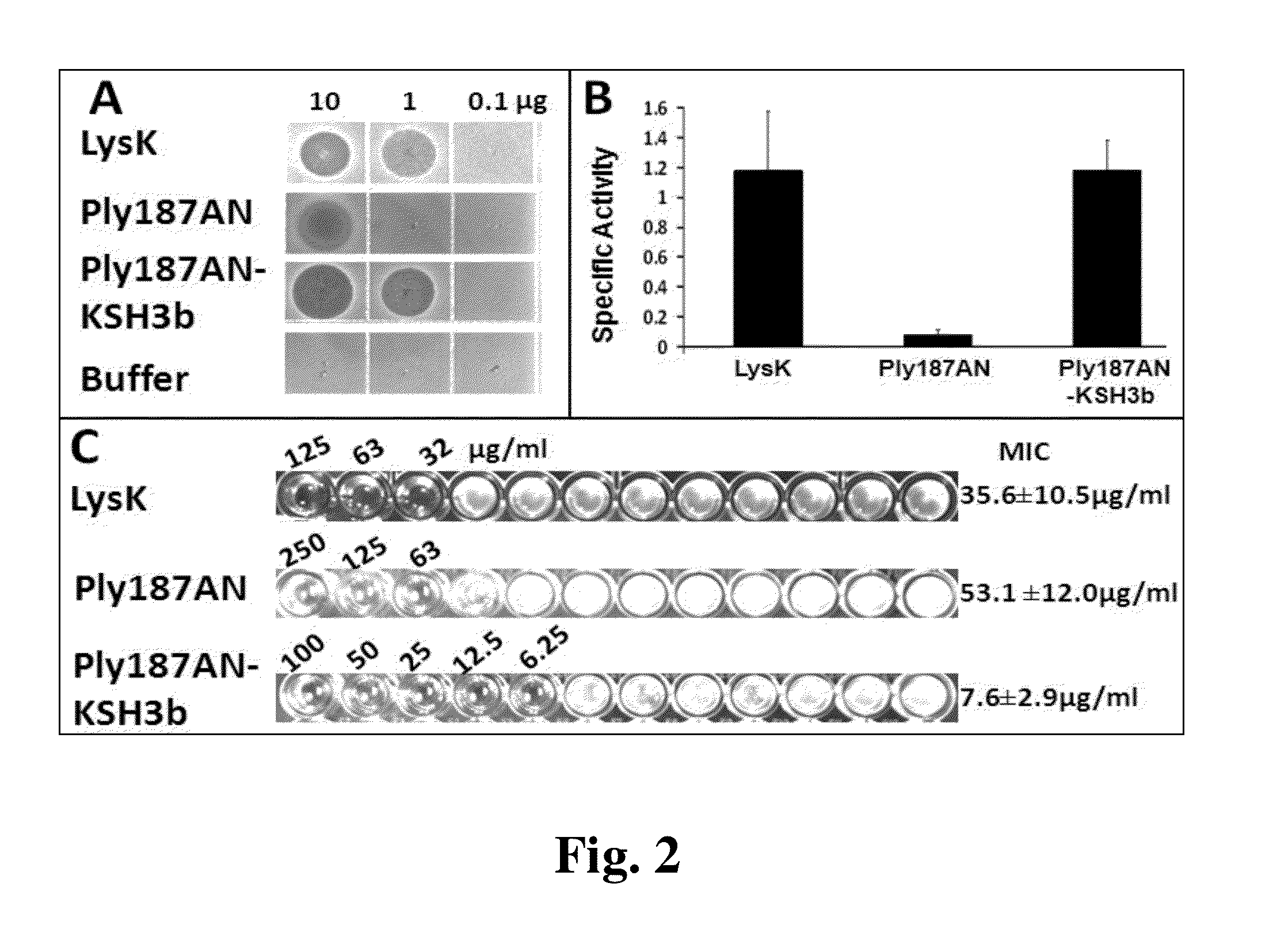Enhanced antimicrobial lytic activity of a chimeric Ply187 endolysin
a technology of endolysin and antimicrobial activity, which is applied in the field of polypeptides, can solve the problems of unlikely bacterial resistance and threat to public health of antibiotic-resistant strains
- Summary
- Abstract
- Description
- Claims
- Application Information
AI Technical Summary
Benefits of technology
Problems solved by technology
Method used
Image
Examples
example 1
Bacterial Strains and Culture Conditions
[0065]Overexpression of proteins was performed in E. coli BL21 (DE3) (Invitrogen, Carlsbad, Calif.) cultured at 37° C. in modified Luria-Bertani (mLB) medium (15 g / l tryptone, 8 g / l yeast extract, 5 g / l NaCl) (Schmelcher et al. 2010. Appl. Environ. Microbiol. 76:5745-5756) supplemented with 150 μg / ml ampicillin for plasmid selection. Staphylococcal strains used are described in Table 1. All strains were grown in Tryptic Soy Broth (TSB) at 37° C.
example 2
Plasmid Constructs; DNA Manipulation
[0066]To enhance the heterologous expression of Ply187 endolysin in E. coli, the sequences encoding the truncated Ply187 N-terminal domain (Ply187AN; 1-157aa) were converted to an E. coli codon bias, commercially synthesized, and subcloned into pUC57 with engineered 5′ NdeI (CATATG; ATG=start of translation) and 3′ XhoI (CTCGAG; codes for aa's LE) restriction enzyme sites (Genscript; Piscataway, N.J.). Subcloning of the Ply187AN construct into the pET21a expression vector was via conventional means for protein expression. Similarly, the Ply187AN was fused to the LysK SH3b by subcloning the Ply187AN NdeI-XhoI DNA fragment harboring all CHAP lytic domain coding sequences into a similarly digested pre-constructed pET21a-KSH3b vector described previously (Becker et al. 2009b. FEMS Microbiol. Lett. 294:52-60). Recombinant LysK was used in this work as a positive control (Becker et al. 2009b, supra).
example 3
Protein Purification and Analysis
[0067]Protein induction, purification and storage followed the protocols as described previously (Becker et al. 2009b, supra). Briefly, Escherichia coli cultures harboring vectors were harvested, then sonicated for 5 min using an automatic pulsing sonication (Bronson Sonifier; Bronson Sonic Power Co., Danbury, Conn., USA). His-tagged proteins were isolated using Ni-NTA nickel column chromatography (Qiagen). Wash and elution profiles were empirically determined to be 10 ml of 10 mM imidazole, 20 ml of 20 mM imidazole and elution with 1.2 ml of 250 mM imidazole in phosphate buffered saline (50 mM NaH2PO4, 300 mM NaCl, pH 8.0) with 1% glycerol to prevent precipitation of the purified protein. All samples were then desalted with Zeba desalting column (Pierce, Rockford, Ill.) equilibrated in 2×PBS buffer and filter sterilized. Sterilized protein preparation was stored at 4° C. in 2×PBS buffer 30% glycerol until the time of assay.
[0068]Nickel-chromatograph...
PUM
| Property | Measurement | Unit |
|---|---|---|
| molecular mass | aaaaa | aaaaa |
| volume | aaaaa | aaaaa |
| Tm | aaaaa | aaaaa |
Abstract
Description
Claims
Application Information
 Login to View More
Login to View More - R&D
- Intellectual Property
- Life Sciences
- Materials
- Tech Scout
- Unparalleled Data Quality
- Higher Quality Content
- 60% Fewer Hallucinations
Browse by: Latest US Patents, China's latest patents, Technical Efficacy Thesaurus, Application Domain, Technology Topic, Popular Technical Reports.
© 2025 PatSnap. All rights reserved.Legal|Privacy policy|Modern Slavery Act Transparency Statement|Sitemap|About US| Contact US: help@patsnap.com


